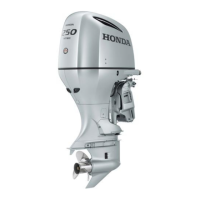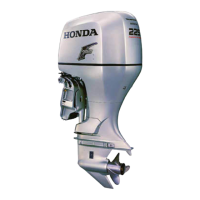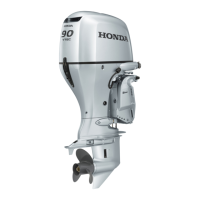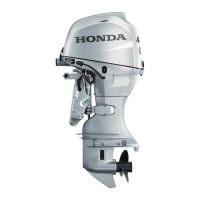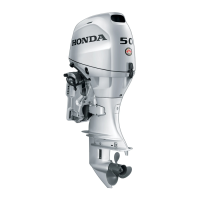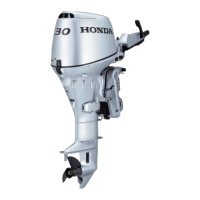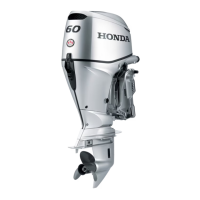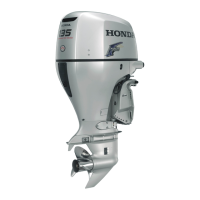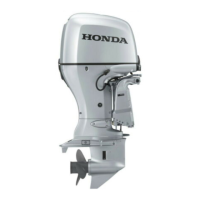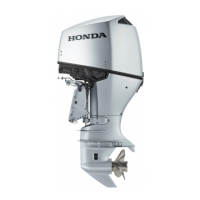Do you have a question about the HONDA marine BF2.3DH and is the answer not in the manual?
Discusses the importance of safety and various forms of safety information provided.
Provides essential safety information for operating the BF2.3D outboard motor.
Details safe practices for refueling the outboard motor.
Warns about the dangers of carbon monoxide from exhaust in enclosed areas.
Identifies and explains the safety labels found on the outboard motor.
Illustrates and explains safety labels specific to Canadian models.
Illustrates and identifies the location of all major components and controls on the motor.
Explains the type codes used to identify specific control and feature applications.
Explains the function and operation of the emergency stop switch and lanyard system.
Describes the choke knob's function in fuel mixture enrichment for starting.
Explains how the throttle grip controls speed and the friction knob adjusts resistance.
Details the function of the fuel valve lever for controlling fuel flow to the engine.
Describes how to operate the starter grip for manual engine starting.
Explains the function of the strap that secures the engine cover.
Details how to adjust the transom angle using the adjusting bolt and wing nut.
Explains how the tilt lever is used to adjust the outboard motor's tilt angle for different operations.
Describes how the steering friction bolt adjusts steering resistance for stable cruising.
Explains the use of clamp screws to securely attach the outboard motor to the transom.
Details the function of the vent knob on the fuel filler cap for sealing the fuel tank.
Explains how the centrifugal clutch automatically engages and transmits power based on engine speed.
Describes how to check the engine oil level using the inspection window.
Explains the purpose of the anode, a sacrificial material, in protecting the motor from corrosion.
Specifies the power requirements and checks before installing the outboard motor on a boat.
Details the correct position and height for installing the outboard motor on the boat's transom.
Describes how to securely attach the outboard motor to the boat's transom using clamp screws and a safety rope.
Explains how to adjust the transom angle for optimal propeller alignment with the water surface.
Guides the user on preparation, knowledge, and familiarization needed before operating the motor.
Emphasizes the importance of pre-operation checks and condition inspection for safety and longevity.
Lists key maintenance items to check before operating the outboard motor.
Lists key safety checks to perform before operating the outboard motor, including leak checks and control verification.
Provides essential precautions for safe operation of the outboard motor, including avoiding enclosed areas.
Details the proper break-in procedure for new outboard motors to ensure smooth wear and long service life.
Provides step-by-step instructions for starting the outboard motor, including safety checks and control operations.
Explains how to start the engine manually using the emergency starter rope if the recoil starter fails.
Describes the procedure for stopping the engine immediately in an emergency using the stop switch.
Details the standard procedure for stopping the outboard motor after operation.
Explains how to use the throttle grip and friction knob for precise speed control.
Provides instructions and safety precautions for operating the motor in reverse gear.
Explains how to steer the boat using the tiller handle and adjust steering resistance with the friction bolt.
Discusses engine speed, transom angle, and techniques for efficient and stable cruising.
Details procedures for tilting the motor for mooring, beaching, and launching operations.
Explains why proper maintenance is essential for safe, economical, and trouble-free operation.
Outlines critical safety precautions to follow during maintenance procedures, including hazard awareness.
Lists the tools supplied with the outboard motor for performing simple maintenance and emergency repairs.
Provides a schedule for regular maintenance tasks based on time intervals or operating hours.
Details the steps for safely removing and reinstalling the engine cover for access to components.
Explains how to accurately check the engine oil level using the inspection window.
Provides guidance on the type of engine oil to use and conditions that can affect oil quality.
Details the procedure for changing the gear case oil, including capacity and torque specifications.
Identifies lubrication points and intervals for applying grease and anticorrosion oil to moving parts.
Explains how to inspect, gap, and replace the spark plug for optimal engine performance.
Provides instructions and critical safety precautions for refueling the outboard motor.
Specifies the recommended type of unleaded gasoline, including acceptable ethanol content limits.
Details how to inspect the recoil starter rope for wear and fraying, and when to replace it.
Explains when and how to replace the anode to ensure continued protection against corrosion.
Provides instructions for safely removing and installing the propeller, including safety precautions.
Outlines essential steps for preparing the outboard motor for long-term storage to prevent damage.
Details how to clean the motor after use, especially in salt water, to prevent corrosion.
Discusses fuel deterioration, storage life, and the use of fuel stabilizers for extended storage.
Explains the procedure for draining fuel from the tank and carburetor to prevent deterioration during storage.
Guides on preparing the engine oil for storage, including oil changes and cylinder lubrication.
Provides critical precautions for choosing a suitable storage location and conditions to prevent damage.
Details essential checks and procedures for safely removing the outboard motor from storage and preparing it for use.
Provides guidance on safely transporting a boat with the outboard motor attached, including securing measures.
Explains how to securely transport the outboard motor after it has been removed from the boat.
Lists common possible causes and step-by-step corrections for an engine that fails to start.
Provides troubleshooting steps for addressing issues of hard starting or the engine stalling shortly after ignition.
Lists possible causes and corrections when the engine runs but the propeller does not engage or move the boat.
Details immediate servicing procedures for a submerged outboard motor to minimize corrosion and prevent damage.
Shows where to find the frame and engine serial numbers for reference and warranty purposes.
Explains carburetor adjustments needed for optimal performance and to prevent issues when operating at high altitudes.
Discusses the engine's emission control system, its components, and compliance with environmental regulations.
Lists symptoms that may indicate issues with the emission control system, requiring dealer inspection.
Explains the meaning of the Star Label for cleaner marine engines and their compliance with emission standards.
Provides detailed technical specifications, dimensions, and performance data for the BF2.3D outboard motor.
Guides on how to find an authorized Honda Marine Servicing Dealer for service and support.
Lists additional official Honda publications providing further information for maintaining and repairing the outboard motor.
Provides contact information for customer support and guidance on handling dealer-related concerns.
Informs about the availability of detailed shop manuals and illustrated parts catalogs for service and repairs.
Outlines the Distributor's Limited Warranty terms for Honda Outboard Motors purchased in the US, Puerto Rico, and US Virgin Islands.
Explains the process for obtaining warranty service, including necessary documentation and steps for resolving issues.
Lists conditions not covered by warranty and disclaims responsibility for consequential damages.
Specifies the warranty coverage for genuine Honda Marine replacement parts and accessories.
Explains the warranty coverage for the engine's emission control system components as per EPA and California regulations.
Details the duration and scope of the manufacturer's warranty for emission control parts, based on model year and usage.
Outlines the owner's obligations, such as performing required maintenance, to maintain warranty coverage.
Summarizes warranty terms, coverage for maintenance items, and liability for damages caused by warranted part failures.
Explains warranty service procedures, lists specific exclusions, and disclaims consequential damages.
Lists specific parts covered under the emission control system warranty and their respective warranty durations.
Outlines the warranty terms for Honda Marine products purchased and operated in Canada.
Details warranty exclusions and the owner's responsibilities for maintaining warranty coverage through proper maintenance.
Specifies the warranty coverage for genuine Honda replacement parts and accessories when purchased and installed correctly.
| Brand | HONDA marine |
|---|---|
| Model | BF2.3DH |
| Category | Outboard Motor |
| Language | English |
